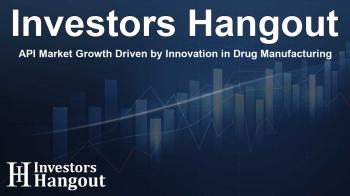API Market Growth Driven by Innovation in Drug Manufacturing

API Market Overview and Growth Projections
The active pharmaceutical ingredients market is projected to expand significantly, reaching USD 359.45 billion by 2030. This growth indicates a robust compound annual growth rate (CAGR) of 5.85% from 2025 to 2030. The driving forces behind this expansion include advancements in API manufacturing processes, the rise of contract manufacturing organizations (CMOs), and increasing interest in biosimilars.
Emerging Trends in the API Sector
An emerging trend is the growth of the captive API segment, where companies invest in overcoming production challenges and developing new chemical methods for in-house API manufacturing. This strategy not only aims to lower costs but also to mitigate contamination risks. Moreover, the incorporation of artificial intelligence and advanced protein synthesis methods is expected to enhance control over manufacturing processes, further facilitating growth.
Demand Factors Shaping the API Market
The surge in demand for active pharmaceutical ingredients is closely linked to the rising incidence of chronic diseases such as cardiovascular diseases (CVD), diabetes, and cancer. Reports indicate that a significant portion of the adult population exhibits risk factors associated with cardiovascular conditions. The increasing prevalence of these diseases has intensified research and development efforts focused on producing effective APIs.
Impact of the COVID-19 Pandemic on API Supply
The ongoing repercussions of the COVID-19 pandemic have had a profound impact on the active pharmaceutical ingredients market. Countries and pharmaceutical companies around the world responded to the urgent need for medications, leading to a dramatic increase in the production of essential components. This scenario illustrated the importance of a robust supply chain capable of adapting to global health crises.
Growth Opportunities in Emerging Markets
The Asia Pacific region is forecasted to exhibit the fastest growth in the API market. This is attributed to substantial investments in emerging economies. Key players are setting up operations in countries like China and India to strengthen their market presence and capitalize on growing generic and innovative API demands.
Challenges in Manufacturing and Pricing Strategies
Despite the positive outlook, stakeholders face challenges due to high manufacturing costs and restrictive drug pricing regulations in various countries. Navigating these obstacles will be crucial for companies striving to maintain profitability while delivering essential medications.
Strategic Investments in the Pharmaceutical Sector
Both established and emerging pharmaceutical companies are increasingly directing funds towards organic and inorganic growth strategies. Investments in mergers and acquisitions, research and development, and product innovations are becoming standard practices in the industry. For example, a leading company recently announced a substantial manufacturing investment aimed at significantly enhancing API production capabilities.
Market Segmentation of Active Pharmaceutical Ingredients
The active pharmaceutical ingredients market can be categorized based on several criteria including type of synthesis and type of manufacturer. This segmentation aids in understanding the dynamics of different market players and the unique challenges they face. The forecasted revenue from these segments shows varied growth potential, reflecting innovations and shifts in consumer demand.
Key Players and Their Contributions
Prominent companies significantly impact the active pharmaceutical ingredients market through varied roles. Their investments in technology and manufacturing capacities play a critical role in shaping the competitive landscape. This includes major pharmaceutical firms that focus on developing both innovative and generic APIs.
Future Directions for Active Pharmaceutical Ingredients
Looking ahead, the active pharmaceutical ingredients market appears poised for continued expansion. Ongoing research, technological advancements, and strategic collaborations will likely facilitate growth. Companies committed to innovation and efficiency in their production processes will stand to gain the most as the market evolves.
Frequently Asked Questions
What is the projected size of the active pharmaceutical ingredients market?
The active pharmaceutical ingredients market is projected to reach USD 359.45 billion by 2030.
What factors are driving growth in the API market?
Key drivers for growth include chronic disease prevalence, innovations in manufacturing, and increased investments in research and development.
Which regions are expected to experience the fastest growth in the API sector?
The Asia Pacific region is expected to witness the highest growth rates due to substantial investments in emerging markets.
What are the challenges faced by stakeholders in the API market?
Challenges include high manufacturing costs and stringent drug pricing regulations in various countries.
How are companies responding to market demands?
Companies are investing in technologies and capacities to enhance production efficiency and meet rising demands for APIs.
About The Author
Contact Logan Wright privately here. Or send an email with ATTN: Logan Wright as the subject to contact@investorshangout.com.
About Investors Hangout
Investors Hangout is a leading online stock forum for financial discussion and learning, offering a wide range of free tools and resources. It draws in traders of all levels, who exchange market knowledge, investigate trading tactics, and keep an eye on industry developments in real time. Featuring financial articles, stock message boards, quotes, charts, company profiles, and live news updates. Through cooperative learning and a wealth of informational resources, it helps users from novices creating their first portfolios to experts honing their techniques. Join Investors Hangout today: https://investorshangout.com/
The content of this article is based on factual, publicly available information and does not represent legal, financial, or investment advice. Investors Hangout does not offer financial advice, and the author is not a licensed financial advisor. Consult a qualified advisor before making any financial or investment decisions based on this article. This article should not be considered advice to purchase, sell, or hold any securities or other investments. If any of the material provided here is inaccurate, please contact us for corrections.

